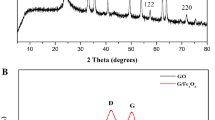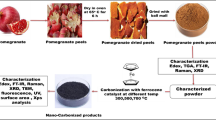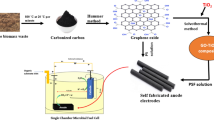Abstract
Development of highly efficient anode is critical for enhancing the power output of microbial fuel cells (MFCs). The aim of this work is to investigate whether modification of carbon paper (CP) anode with graphene (GR) via layer-by-layer assembly technique is an effective approach to promote the electricity generation and methyl orange removal in MFCs. Using cyclic voltammetry and electrochemical impedance spectroscopy, the GR/CP electrode exhibited better electrochemical behavior. Scanning electron microscopy results revealed that the surface roughness of GR/CP increased, which was favorable for more bacteria to attach to the anode surface. The MFCs equipped with GR/CP anode achieved a stable maximum power density of 368 mW m−2 under 1,000 Ω external resistance and a start time for the initial maximum voltage of 180 h, which were, respectively, 51 % higher and 31 % shorter than the corresponding values of the MFCs with blank anode. The anode and cathode polarization curves revealed negligible difference in cathode potentials but obviously difference in anode potentials, indicating that the GR-modified anode other than the cathode was responsible for the performance improvement of MFC. Meanwhile, compared with MFCs with blank anode, 11 % higher decolorization efficiency and 16 % higher the chemical oxygen demand removal rate were achieved in MFC with GR-modified anode during electricity generation. This study might provide an effective way to modify the anode for enhanced electricity generation and efficient removal of azo dye in MFCs.







Similar content being viewed by others
References
Logan BE, Aelterman P, Hamelers B, Rozendal R, Schröeder U, Keller J, Freguiac S, Verstraete W, Rabaey K (2006) Microbial fuel cells: methodology and technology. Environ Sci Technol 40:5181–5192
Cheng SA, Liu H, Logan BE (2006) Increased power generation in a continuous flow MFC with advective flow through the porous anode and reduced electrode spacing. Environ Sci Technol 40:2426–2432
Katuri K, Ferrer ML, Gutierrez MC, Jimenez R, del Monte F, Leech D (2011) Three-dimensional microchanelled electrodes in flow-through configuration for bioanode formation and current generation. Energy Environ Sci 4:4201–4210
Wang X, Cheng SA, Feng YJ, Merrill MD, Saito T, Logan BE (2009) Use of carbon mesh anodes and the effect of different pretreatment methods on power production in microbial fuel cells. Environ Sci Technol 43:6870–6874
Cai H, Wang J, Bu YF, Zhong Q (2013) Treatment of carbon cloth anodes for improving power generation in a dual-chamber microbial fuel cell. J Chem Technol Biotechnol 88:623–628
Ci SQ, Wen ZH, Chen JH, He Z (2012) Decorating anode with bamboo-like nitrogen-doped carbon nanotubes for microbial fuel cells. Electrochem Commun 14:71–74
Luo JM, Chi ML, Wang HY, He HH, Zhou MH (2013) Electrochemical surface modification of carbon mesh anode to improve the performance of air-cathode microbial fuel cells. Bioprocess Biosyst Eng 36:1889–1896
Lai B, Tang XH, Li HR, Dua ZW, Liu XW, Zhang Q (2011) Power production enhancement with a polyaniline modified anode in microbial fuel cells. Biosens Bioelectron 28:373–377
Wang YQ, Li B, Zeng LZ, Cui D, Xiang XD, Li WS (2013) Polyaniline/mesoporous tungsten trioxide composite as anode electrocatalyst for high-performance microbial fuel cells. Biosens Bioelectron 41:582–588
Sun JJ, Zhao HZ, Yang QZ, Song J, Xue A (2010) A novel layer-by-layer self-assembled carbon nanotube-based anode: preparation, characterization, and application in microbial fuel cell. Electrochim Acta 55:3041–3047
Xie X, Hu LB, Pasta M, Wells GF, Kong DS, Criddle CS, Cui Y (2011) Three-dimensional carbon nanotube-textile anode for high-performance microbial fuel cells. Nano Lett 11:291–296
Sun M, Zhang F, Tong ZH, Sheng GP, Chen YZ, Zhao Y (2010) A gold-sputtered carbon paper as an anode for improved electricity generation from a microbial fuel cell inoculated with Shewanella oneidensis MR-1. Biosens Bioelectron 26:338–343
Xu ST, Liu H, Fan YZ, Schaller R, Jiao J, Chaplen F (2012) Enhanced performance and mechanism study of microbial electrolysis cells using Fe nanoparticle-decorated anodes. Appl Microbiol Biot 93:871–880
Peng XH, Yu HB, Wang X, Zhou QX, Zhang SJ, Geng LJ (2012) Enhanced performance and capacitance behavior of anode by rolling Fe3O4 into activated carbon in microbial fuel cells. Bioresour Technol 121:450–453
Ozkaya B, Akoglu B, Karadag D, Acı G, Taskan E, Hasar H (2012) Bioelectricity production using a new electrode in a microbial fuel cell. Bioprocess Biosyst Eng 35:1219–1227
Chen D, Tang LH, Li JH (2010) Graphene-based materials in electrochemistry. Chem Soc Rev 39:3157–3180
Gan T, Hu SS (2011) Electrochemical sensors based on graphene materials. Microchim Acta 175:1–19
Liu J, Qiao Y, Guo CX, Lim S, Song H, Li CM (2012) Graphene/carbon cloth anode for high-performance mediatorless microbial fuel cells. Bioresour Technol 114:275–280
Zhao C, Wang Y, Shi FJ, Zhang JR, Zhu JJ (2013) High biocurrent generation in Shewanella-inoculated microbial fuel cells using ionic liquid functionalized graphene nanosheets as an anode. Chem Commun 49:6668–6670
Yong YC, Dong XC, Chan-Park MB, Song H, Chen P (2012) Macroporous and monolithic anode based on polyaniline hybridized three-dimensional graphene for high-performance microbial fuel cells. ACS Nano 6:2394–2400
Xiao L, Damiena J, Luo JY, Jang HD, Huang JX, He Z (2012) Crumpled graphene particles for microbial fuel cell electrodes. J Power Sources 208:187–192
Zhang YZ, Mo GQ, Li XW, Zhang WD, Zhang JQ, Ye JS, Huang XD, Yu CZ (2011) A graphene modified anode to improve the performance of microbial fuel cells. J Power Sources 196:5402–5407
Hou JX, Liu ZL, Zhang PY (2013) A new method for fabrication of graphene/polyaniline nanocomplex modified microbial fuel cell anodes. J Power Sources 224:139–144
Fan J, Guo YH, Wang JJ, Fan MH (2009) Rapid decolorization of azo dye methyl orange in aqueous solution by nanoscale zerovalent iron particles. J Hazard Mater 166:904–910
Solanki K, Subramanian S, Basu S (2013) Microbial fuel cells for azo dye treatment with electricity generation: a review. Bioresour Technol 131:564–571
Sun J, Li YM, Hu YY, Hou B, Zhang YP, Li SZ (2013) Understanding the degradation of Congo red and bacterial diversity in an air–cathode microbial fuel cell being evaluated for simultaneous azo dye removal from wastewater and bioelectricity generation. Appl Microbiol Biotechnol 97:3711–3719
Dong SY, Sun JY, Li YK, Yu CF, Li YH, Sun JH (2014) ZnSnO3 hollow nanospheres/reduced graphene oxide nanocomposites as high-performance photocatalysts for degradation of metronidazole. Appl Catal B: Environ 144:386–393
Yu HH, Cao T, Zhou LD, Gu ED, Yu DS, Jiang DS (2006) Layer-by-layer assembly and humidity sensitive behavior of poly(ethyleneimine)/multiwall carbon nanotube composite films. Sens Actuators B: Chem 119:512–515
Oh S, Min B, Logan BE (2004) Cathode performance as a factor in electricity generation in microbial fuel cells. Environ Sci Technol 38:4900–4904
Wei LL, Han HL, Shen JQ (2012) Effects of cathodic electron acceptors and potassium ferricyanide concentrations on the performance of microbial fuel cell. Int J Hydrogen Energy 37:12980–12986
Arnold G (2005) Standard methods for the examination of water and wastewater, 21st edn. American Public Health Association (APHA), Washington, DC
Liu Y, Liu Y, Feng HB, Wu YM, Joshi L, Zeng XQ, Li JH (2012) Layer-by-layer assembly of chemical reduced graphene and carbon nanotubes for sensitive electrochemical immunoassay. Biosens Bioelectron 35:63–68
Sheng KX, Bai H, Sun YQ, Li C, Shi GQ (2011) Layer-by-layer assembly of graphene/polyaniline multilayer films and their application for electrochromic devices. Polymer 52:5567–5572
Bard AJ, Faulkner LR (2001) Electrochemical methods: fundamentals and applications, 2nd edn. Wiley, New York
Qiao Y, Bao SJ, Li CM, Cui XQ, Lu ZS, Guo J (2008) Nanostructured polyaniline/titanium dioxide composite anode for microbial fuel cells. ACS Nano 2:113–119
Qiao Y, Li CM, Bao SJ, Bao QL (2007) Carbon nanotube/polyaniline composite as anode material for microbial fuel cells. J Power Sources 170:79–84
Feng CH, Ma L, Li FB, Mai HJ, Lang XM, Fan SS (2010) A polypyrrole/anthraquinone-2,6-disulphonic disodium salt (PPy/AQDS)-modified anode to improve performance of microbial fuel cells. Biosens Bioelectron 25:1516–1520
Ci SQ, Wen ZH, Chen JH, He Z (2012) Decorating anode with bamboo-like nitrogen-doped carbon nanotubes for microbial fuel cells. Electrochem Commun 14:71–74
Galindo C, Jacques P, Kalt A (2000) Photodegradation of the aminoazobenzene acid orange 52 by three advanced oxidation processes: UV/H2O2, UV/TiO2 and VIS/TiO2: comparative mechanistic and kinetic investigations. J Photochem Photobiol A: Chem 130:35–47
Cao YQ, Hu YY, Sun J, Hou B (2010) Performance improvement of air-cathode single-chamber microbial fuel cell using a mesoporous carbon modified anode. Bioelectrochem 79:71–76
Acknowledgments
The authors are grateful to the financial support from the Plan for Scientific Innovation Talent of Henan Province (Grant No. 134200510014), the Basic and Cutting-Edge Technology Research Project of Henan province (Grant No. 112300410157), and the Innovation Scientists and Technicians Troop Construction Projects of Henan Province.
Author information
Authors and Affiliations
Corresponding author
Rights and permissions
About this article
Cite this article
Guo, W., Cui, Y., Song, H. et al. Layer-by-layer construction of graphene-based microbial fuel cell for improved power generation and methyl orange removal. Bioprocess Biosyst Eng 37, 1749–1758 (2014). https://doi.org/10.1007/s00449-014-1148-y
Received:
Accepted:
Published:
Issue Date:
DOI: https://doi.org/10.1007/s00449-014-1148-y




